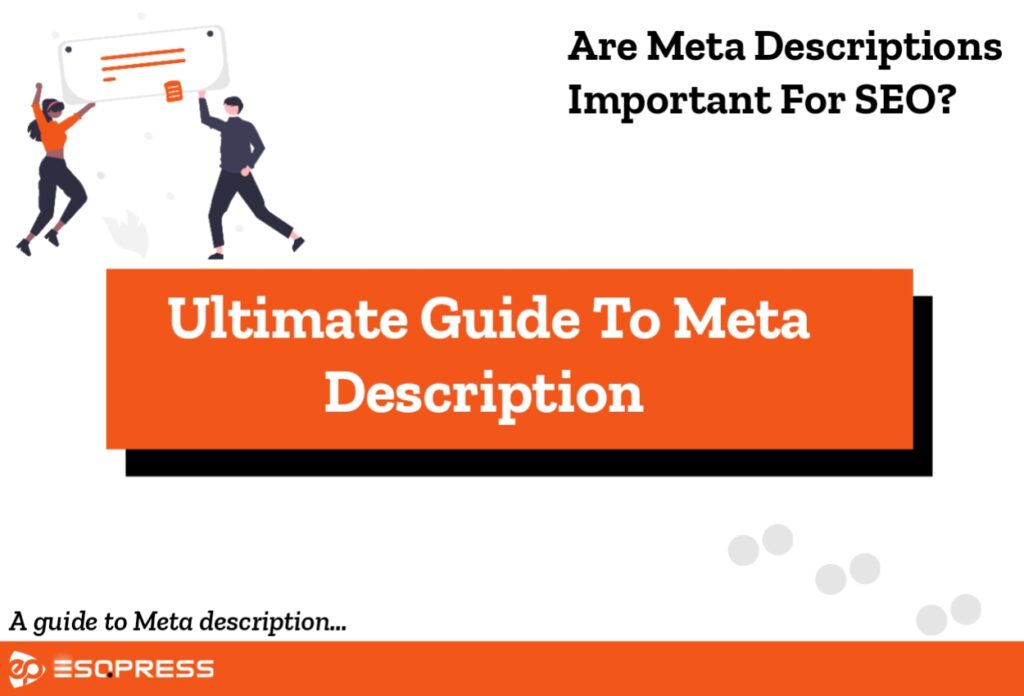Contents
- 1 Meta Description Minimum length
- 2 Are Meta Descriptions Important?
- 3 How To Write a Good Meta Description
- 3.0.1 1. Stick to the Length Of Meta Description
- 3.0.2 2. Try as Much as Possible To Add Keywords Naturally
- 3.0.3 3. Avoid The Use of Quotation Marks
- 3.0.4 4. Write-In Your Brands Tone
- 3.0.5 5. Always Use Active Voice
- 3.0.6 6. Make Your Meta Description Relevant
- 3.0.7 7. Find Possible Chance To Include CTA
- 4 Is it Possible To Add Multiple Meta Descriptions?
- 5 How To Add Meta Description To Web Pages
You might have heard of the term “meta description” from a forum, group, a blog, name them! But what really is a meta description? Does it affect SEO? Can I rank SERPS with it? These are all questions probably roaming your mind. Well, in this article, we’ll be taking on an Ultimate Guide on meta description in SEO.
You may have probably optimized certain areas of your blog, such as your images, pages, and even doing proper keyword research. However, until you nail the meta description of your web pages, your effort is incomplete. Yeah, I said so!
Because meta descriptions are so vital for on-page SEO, it’s crucial to make them optimized for both readers and search engines. We’ll explain how meta descriptions operate and provide you with a step-by-step strategy for writing them and how they can help you convert.
What is a Meta Description?
A Meta description is a very short summary of a web page written as an HTML attribute. Meta descriptions are not visible on a web page but rather displayed on search engines. It is a brief snippet found under a site’s title in Google’s search results.

If you noticed, there are 3 features in this search results. First, the text in blue color which is the title, technically known as the Title tag, displays the title of the page. Below that, you’ll most likely see the URL of the page in green color followed by the meta descriptions; text in black color.
Meta Description Minimum length
Initially, Google prescribed meta description length was settled at 320 characters. Many SEO’s were overly enthusiastic and started rewriting meta descriptions to match the length prescribed. Shortly after, in 2018, May precisely, Google surprisingly reduced the length to 160 characters.
After this update, Google received a lot of comments from obsessed people who wanted to clarify themselves on the best approaches to write good meta descriptions. Google’s response to this was quite vague.
Google has severally stated that people should not focus on numbers in the meta descriptions but rather on quality content delivery.
Google has never specifically defined how long meta descriptions should be. In fact, Danny Sullivan, Google’s public liaison for search, warned against writing duplicated descriptions.

In summary, meta descriptions have no assigned number of words but best practices suggest that your meta description word count should range from 140 words to 160 on desktop.
It is also essential to note that Google doesn’t always make use of the custom meta description inserted. Most times, when a meta description is not written well relative to Google standard or does not match a searcher query, it automatically creates a meta description from the article contents to serve the searcher’s intent. As for a fact, the only meta description Google fully honors are meta descriptions of sites homepage.
Are Meta Descriptions Important?

Back then, in the early years of search engines, the meta description was fully employed as a ranking factor for google’s algorithm to help determine page ranking in search results. This factor, initially, helped to solve searchers’ queries not until bloggers and website owners started using this approach negatively by stuffing unnecessary keywords on their page meta description intending to manipulate search engines. This gradually resulted in a high level of spamming on Google SERPS.
When Google noticed this, they planned on closing meta description as a ranking factor. In September 2009, Google officially announced that meta descriptions and meta keywords will no longer have any significant effect on page ranking.
In other words, meta descriptions have little (who knows! since the google algorithm seems to be opaque) or no effect on SEO.
However, Meta descriptions are still important as they play a predominant role in increasing CTR (click-through rates) alongside the title tag. As a result, it’s crucial to spend some work time on meta descriptions, among other things.
How To Write a Good Meta Description
Although meta descriptions don’t contribute much-ranking signal, it partakes massively to the CTR (click-through rate) of a webpage, which is a potential ranking factor.
When writing a meta description, think of it as an advertisement copy in a traditional publication; where to make conversions, your title and blurb must be able to entice readers to make purchases or even use your services. The same case goes for your meta description, it should be compelling, accurate, original, and clear.
Below are best practices to employ when writing a meta description
1. Stick to the Length Of Meta Description
For best results, your meta description should be able to maintain a range of 140 – 160 words. Meta descriptions longer than the ideal meta description length (160 words), would be truncated by Google and hence be vague for searchers. In other words, the rule of meta description length is “Better shorter than Longer” I.e. your meta description is better to be shorter than 160 than to be longer
2. Try as Much as Possible To Add Keywords Naturally
Although keywords in meta descriptions might not increase rankings, it is ideal that you add them in the best possible natural way. It’s also worth noting that when keywords in the description match search queries, Google and other search engines usually make them bold. Since these keywords in bold tend to draw the attention of searchers, it’s ideal you use them effectively. Although, avoid stuffing keywords, or else you’ll get penalized.
3. Avoid The Use of Quotation Marks
According to Moz, an SEO-focused company, Google truncates meta descriptions with quotation marks.
To avoid this, make sure that all non-alphanumeric characters are removed from meta descriptions. If your meta description requires quotation marks, you can use the HTML entity instead of double quotes to avoid truncation.
4. Write-In Your Brands Tone
When writing a meta description, Maintain your brand’s voice and tone while remaining personable. Whether formal, informal, emotional, etc, there are no limitations to the tone of your meta description. Just keep it straightforward, in the tone of your website.
5. Always Use Active Voice
Most times people, especially newbies, become overwhelmed in ignorance of passive voice. Here is one crucial thing, although passive voice sounds a bit fancier, active voice is proactive and tends to pass strong, clear information that sounds more authentic and can compel readers. Instead of using statements like; “you’ll can find all phone accessories here”, use “We sell all phone accessories here”.
6. Make Your Meta Description Relevant
When writing a meta description make sure your meta description is relevant and can answer a searcher’s query relating to the keyword. Imagine writing a meta description on how to repair create a blog on an e-commerce website, it sounds insane, right? smiles…
7. Find Possible Chance To Include CTA
A call-to-action should always be included in a description to entice users to click on the result.
Is it Possible To Add Multiple Meta Descriptions?
Since you’re the one in control of your site, you can add as many meta descriptions you wish to. But when writing for a search engine, it’s a No from me!.
Many people often use this technique, with the aim to write various meta descriptions that will possibly match searchers queries. But I’ll tell you the gospel truth, it is risky! because google can see this approach as to black hat SEO.
In other words, implementing meta description is at your own risk.
How To Add Meta Description To Web Pages
Since meta descriptions are found in the HTML code of a page, adding an extra meta description to a page is reliant on the website-building application you use.
You’ll need access to your site’s HTML pages, as well as the ability to edit and amend them, in order to add various meta descriptions.
A meta description element must be placed between the head tags in HTML code and, for optimal results, below the page’s title tag.
If you use Blogger to blog, to add a meta description, you will need to access your blogger dashboard, click on the pen-like structure and then select Html view.
If you use WordPress to blog, you can simply add a meta description without accessing the page code by installing one of many available SEO plugins such as; AIOSEO, Yoast, Rank maths and others.





